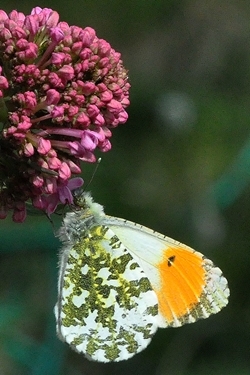Orange-tip butterfly
 One of my favourite butterflies is the orange-tip (Anthocharis cardamines). It is such a brilliant indicator that spring has finally arrived, a splash of colour as it flits along the sunny hedge bank, looking for an early flower to drink nectar from.
One of my favourite butterflies is the orange-tip (Anthocharis cardamines). It is such a brilliant indicator that spring has finally arrived, a splash of colour as it flits along the sunny hedge bank, looking for an early flower to drink nectar from.
Only the male carries the showy orange tips to the wings and so many folk will often assume that it is a small white butterfly that they have just seen, when in fact it may well have been a female orange-tip. Should either the male or female land, take a look at the beautiful mosaic of mottled greens that pattern the underwing, such a magical hidden surprise that tells you that this is indeed an orange-tip you are observing.
The species is found throughout England, Wales and Ireland, but is somewhat local further north and especially in Scotland. Orange-tips use a wide range of habitats including farmland, hedgerows, woodland edge and rides within forests, and they also show a preference for water meadows, where one of their main caterpillar food plant grows: the lady’s smock or cuckoo flower.
There is a single brood each year, with adults flying from the beginning of April, through May and into June. By the end of July most have pupated and spend the next eight months as a chrysalis.
Eggs are a greenish-white when first laid, but gradually turn orange and are one of the easiest eggs of all species to find, tucked away on a flower stalk of foodplants such as lady’s smock, hedge mustard (or “Jack next to the hedge”, as many country folk call it!) and even honesty growing in your garden.
Last spring, I watched a female lay her eggs, one at a time on different plants, on the underside of the flowers of hedge mustard growing alongside a small sunny copse. The caterpillars can be cannibalistic on each other, so she ensures that they each have a plant to themselves.
I made a mental note of the position, deciding that I would keep an eye on these plants so that I could photograph the caterpillars munching away on the seed pods, and maybe at a later date, even find the chrysalis that will be fixed to a nearby plant stem. I returned ten days later, camera in hand, only to find that every single flower head had been chewed off by deer, consuming the next generation of orange-tips at the same time.
The larval stage only lasts between three and four weeks before the pupa is formed on a nearby plant stem, attached by a silk girdle. The chrysalis is green when first made; however, it eventually turns light brown in order to match its surroundings.
The orange-tip plays an important role in phenology - the measure of changes in the timing of natural events during the year. The spring index is calculated from the dates of four different annual biological events: the first recorded flowering of hawthorn and horse chestnut, and the first recorded sighting of a swallow, and of an orange-tip butterfly.
Interestingly, the first flowering of hawthorn and horse chestnut and the first flight of the orange-tip butterfly were all 10-12 days earlier between 1998-2006, when compared with 1900-47. However, the first sighting of the migratory swallow showed little or no change. If you are interested in finding out more about phenology and perhaps even reporting your first sightings, then see the Joint Nature Conservation Committee website.
Peter Thompson
Advisory
Read more from Peter Thompson at his blog.

Download Peter Thompson's essential 26-page book, featuring beautiful photography and detailed profiles of Britain's wildlife
Download FREE >